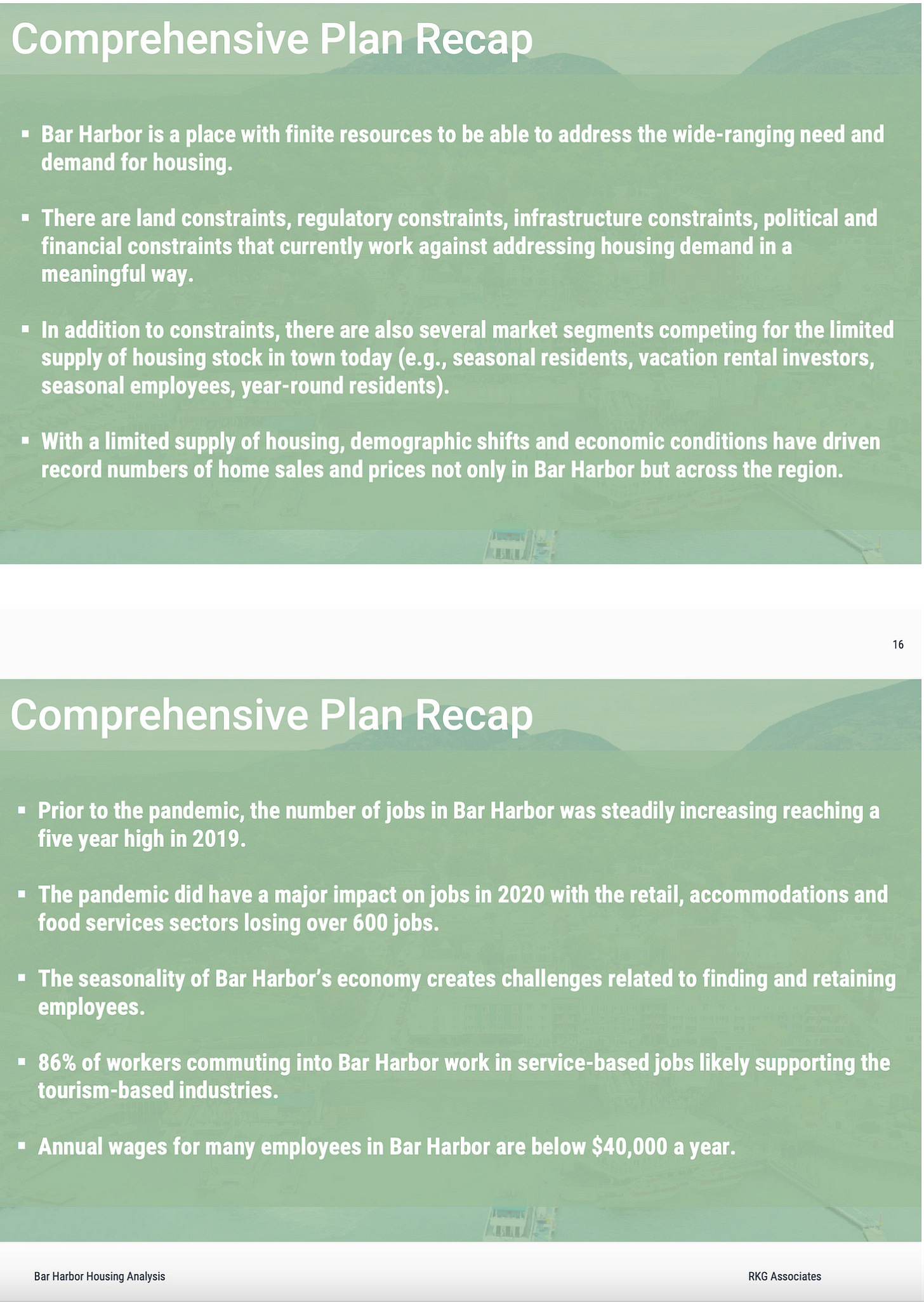From Crisis to Collaboration:
MDI Residents and Organizations Band Together to Tackle Housing Shortage
BAR HARBOR—Noel Musson knows firsthand about the housing crisis on Mount Desert Island. Born and raised on MDI, he did as so many do and moved away to attend college and get started on his life’s journey. About 18 years ago, he and his wife decided that they wanted to move back. They could not find an affordable house and had to stay with his wife’s parents in Bar Harbor for a couple of months while they looked for a home of their own.
Eventually, thinking outside of the box, they partnered with another couple and purchased a house in Southwest Harbor with a couple of acres of land. Later on, they were able to buy out their partners and now own the house and land themselves.
In 2012 Musson started the Musson Group. From its website, the Musson Group states that it is “a planning consultancy specializing in land use and community planning, economic development, geographic information services (GIS), permitting, and project management. Founded in 2012, The Musson Group is a leader in project management, planning, and permitting in the state of Maine.”
Based in Southwest Harbor, the Musson Group has worked locally for the towns of Mount Desert, Southwest Harbor, and Tremont. Musson said that his company has not yet worked for the Town of Bar Harbor but has had customers from Bar Harbor.
Musson says that his planning experiences working with clients around the island were what really drove home the issues surrounding development on the island and got him thinking about the event.
Musson decided to organize a meeting of industry professionals with the goal of tackling the barriers to development across the whole of Mount Desert Island rather than for just any one town in particular.
On Friday, March 24, 2023, Musson and others will facilitate the first MDI Housing Solutions Summit. The summit will take place at the MDI Biological Laboratory and will run from 9 a.m. until 3 p.m.. Attendance at the summit is by invitation only and it is not open to the general public or the press.
The planners and creators (the steering committee members) who have helped put this event together include Susanne Paul from the Musson Group, and staff members from the Island Housing Trust, Friends of Acadia, the Knowles Company, the Town of Bar Harbor, and Maine Coast Heritage Trust.
The steering committee has invited industry professionals from the following sectors: major area employers, nonprofits, business leaders, bankers, real estate sales and development, engineers, and architects.
The objectives of the summit are to create a framework that achieves significant progress in addressing the housing crisis; build new social connections between institutions and organizations grappling with the same issue; create a common understanding of MDI housing needs; create a common understanding of the barriers preventing those needs from being met; create a common understanding of what solutions are currently underway; and identify new solutions to meet housing needs and overcome barriers.
With the understanding that these kinds of events have taken place before and had success, but not longevity, one of the summit’s goals is to ensure that there is consistent follow up and accountability by the working groups. One objective is to have the groups meet several times a year, develop a plan of attack to achieve a solution to the group’s area of focus, and then to have every group meet again at next year’s summit to present the group’s progress and the status of its work.
No group, entity, or individual has hired the Musson Group to organize the summit. To date all the work done to organize this event by the Musson Group and members of the Steering Committee have been strictly a volunteer effort by community members. There were requests for donations for the expenses of the summit.
MDI IS NOT ALONE IN ITS WOES
Comprehensive Plan Committee members, Bar Harbor planning department staff, and town councilors have all been focused on affordable housing in the town. State agencies and officials are also trying to come up with ideas to promote housing options on Mount Desert Island and across Maine.
An article by Lora Whelan for the Maine Monitor calls the situation a housing crisis. She cites an employee from Down East Community Hospital, Jennifer Sutherland, who stayed in a women’s shed in a backyard for a month while searching for a place to stay. With no options, Sutherland built her own shed-style housing in an off-the-grid spot a bit of a commute away. She takes showers at the local gym.
In Bar Harbor, it’s not uncommon to see seasonal employees sleeping in cars and trucks on lower School Street or various other streets. Some camp in driveways or campgrounds. The need for housing extends beyond seasonal employees. On Monday, March 20, there were 11 homes listed on Zillow (a real estate website) ranging from a 980-square-foot mobile home for $289,000 to an $11 million estate. Only two houses were less than $500,000. Affordable homes are scarce. Year-round rentals on MDI are also scarce.
In Hancock County the median sold price for homes increased from $175,000 in 2010 to $355,000 in 2022. There were 769 sales in Hancock County in 2022. In 2010 there were 429.
Nancy Smith, the CEO of GrowSmart Maine, lives in Ellsworth. She told Whelan and the Bar Harbor Story that there are multiple pressures on housing. People migrating into the state and investor-owned short-term rentals, aging housing stock, Maine’s status as a vacation destination and its number of second homes, all combine to elevate prices and decrease stock. Similarly, interest rates on loans and mortgages are currently high, building materials are high, and labor costs are high. Regional solutions, she stressed, are the best approach, especially when it comes to short-term rentals.
Compounding the problem is that when housing is built outside of a town’s main compact, it brings costly infrastructure needs for sewer and water lines, or it can increase demands on aquifers. Bar Harbor Appeals Board Chair Ellen Dohmen, at a special Town Council meeting last week, spoke to four of her neighbors’ wells running dry last week. She lives, she said, about two miles outside of the downtown compact.
There are bills being proposed at the state level that would redefine terms associated with housing development. Some try to create middle-income housing. Some try to protect land. Some, such as that proposed by GrowSmart Maine and BuildMaine, Whelan writes, “would create a cohesive approach to development that strengthens the existing infrastructure and culture of downtowns and villages of all sizes.”
Bar Harbor’s planning department has already begun trying to streamline the development process through steps in procedure and potential tweaks to the land use ordinance.
A PROBLEM EVERYWHERE
Smith said that Bar Harbor, MDI, and Hancock County are not alone in its housing woes.
“Lack of housing choices has been perceived as a problem facing only some parts of Maine…until the past few years. Now, even our most rural communities are seeing interest from people who are choosing to live here, either because of all the quality of life attributes Maine has to offer, or more specifically, because of long term concerns of climate change and the chance to rethink where they chose to live after enduring pandemic lockdowns,” she said.
It's an expected trend for a state that has bemoaned the loss of its young people to opportunities elsewhere. Now, there is a saying, ‘Drive ‘til you qualify,’ which basically means get on the road and drive until you can afford a mortgage and a house.
“‘Drive ‘til you qualify’ has been an issue for southern Maine, also for those who work in Maine’s seafood industry, as demonstrated by lobster traps stacked neatly outside homes that are far from the coast. This presents tremendous opportunities for Maine towns and cities, some of which have faced declining populations for decades,” Smith said. “New families bring new students to our schools, new energy to our nonprofits and municipal committees, and a more diverse population that strengthens each town.”
Like everything, however, it isn’t quite that simple. Smith said,
“But the challenges are real too: conversions to short-term rentals that remove housing stock from the mix for year-round residents; greater competition for the limited homes available for purchase or rental; and the higher prices that come with both of those challenges. At the state level, GrowSmart Maine is working with a broad mix of organizations and individuals through Policy Action 2023 to address these issues. Some of the proposals are smart incremental steps, like proposing a few subdivision laws, while others are pretty bold, like a complete overhaul of the Growth Management Law. Locally, we encourage residents to participate in municipal committees, commissions, and boards, where so many critical decisions are made.”
And some, like those attending the summit, are also hoping to create strategies concurrently.
“There is a huge need” for housing, Erik Woyciesjes, a market analyst with RKG Associates told the Bar Harbor Comprehensive Planning Committee in January. He added that as things change that number could also change. Housing constraints could stymie the population increase, Woyciesjes said.
Bar Harbor’s population has increased from 4,820 in 2000 to 5,527 in 2020. It’s projected that by 2038, it will have more than 6,000 residents, an increase of 15%. There is some degree of error in the sampling area, and it’s not a perfect science, but it’s still an increase that has supply constraints working against that projected growth.
PROPERTY TAXES
Another part of the equation is property taxes, which are what many states and municipalities bill to home owners. The amount is based on a property’s value and the tax rate or mil rate of the location. While the property taxes aren’t often thought of as a barrier to an affordable home, that as well as water, sewer, electricity and other bills combine to make the cost of living in a home beyond some people’s reach.

For a median home in Maine, the property tax rate in the second quarter of 2022 was 1.36% or $4,928. The last column in the graph below by Bankright shows how Maine compares to some other states.
Many worry that increasing tax rates and home assessments make living in some communities unaffordable even for long-time home owners as well as for families who are just starting out and have managed to find a home.
LINKS TO LEARN MORE
You can learn more about MaineGrow’s public policy link on its website: https://growsmartmaine.org/public-policy/
https://www.themussongroup.com/
https://barharborstory.com/2023/01/12/it-takes-a-region-to-deal-with-housing-issues/
To read the report in full, go here. Also in the packet is the plan’s “Phase 1: Community Engagement Report,” which we’ll have an article on shortly.
Where Have All The Starter Homes Gone?
https://www.bankrate.com/real-estate/property-tax-by-state/#by-stat
https://www.mainerealtors.com/wp-content/uploads/2023/01/Hancock22Data.pdf
https://www.barharbormaine.gov/501/Comprehensive-Plan
https://www.townhallstreams.com/stream.php?location_id=37&id=49643
https://www.barharbormaine.gov/517/Comprehensive-Planning-Committee
https://www.barharbormaine.gov/AgendaCenter/ViewFile/Agenda/_01112023-3121
https://legislature.maine.gov/doc/8866
Town’s Housing Surveys Released
https://legislature.maine.gov/increase-housing-opportunities-in-maine-study

















